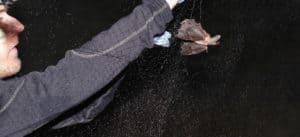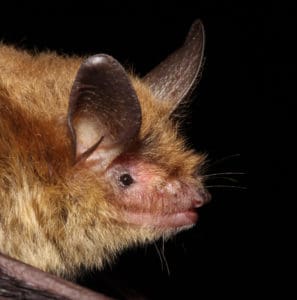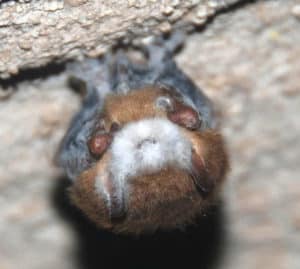Share this article
WNS takes a toll on West Virginia bat populations
Populations of several bat species plummeted in West Virginia due to the spread of the deadly white-nose syndrome over the past decade, according to long-term surveys.
White-nose syndrome has decimated bat populations across much of North America. A fungal disease, it kills affected bats during hibernation periods, causing them to use more energy than uninfected bats during colder winter weather.

A researcher extracts a Virginia big-eared bat (Corynorhinus townsendii virginianus) from a mist net. Credit: Tim Jones
Researchers in the Monongahela National Forest in West Virginia wondered how it was affecting the state’s 11 known bat species. Biologists had conducted mist net surveys for bats at hundreds of different sites in the forest since the late 1990s—before white-nose syndrome emerged—and recorded the species, body condition and sex of the bats they captured.
“It became very fortuitous that we had all this data before white-nose syndrome hit,” said Catherine Johnson, who then worked as the wildlife program manager for the Monongahela National Forest.
In a study published recently in Ecology and Evolution, Johnson and her colleagues split the data into two portions. They compared data from 2003 to 2008, before WNS was confirmed in the state, to data taken on surveys from 2011 to 2019, after it had spread through West Virginia.

Northern long-eared bats were among those that declined after white-nose syndrome struck West Virginia. Credit: Keith Christenson
“We could see this long-term change,” said Johnson, who now works as a coastal ecologist with the National Park Service.
They found that three species declined dramatically after WNS hit the state: little brown bats (Myotis lucifugus), northern long-eared bats (Myotis septentrionalis) and tricolored bats (Perimyotis subflavus). Those trends matched data gathered from other research conducted on hibernacula counts, Johnson said.
The population of big brown bats (Eptesicus fuscus) and eastern red bats (Lasiurus borealis), however, actually increased after WNS appeared in the state.
Johnson isn’t sure why, but other research has shown that big brown bats may benefit from more prey availability when WNS diminishes other species. They may also benefit from more quality roost space, Johnson said.
Other bat species, like federally endangered Indiana bats (Myotis sodalis), also declined but were so rare even before WNS that it was hard to tell what was happening statistically, Johnson said.

A tricolored bat with white-nose syndrome symptoms visible on its nose. Credit: Craig Stihler
The researchers also found that two species—northern long-eared bats and big brown bats—began to breed 5 to 6 days earlier on average in recent years. That may be attributed to the spread of the disease, Johnson said, or it may be due to climate change.
“These bats are dealing with so many different things at the same time,” she said. “White nose syndrome is one, but there’s also habitat loss, disturbance of hibernacula and maternity roosts, climate change and many other stressors.”
Header Image:
Researchers found that little brown bats in West Virginia declined due to white-nose syndrome.
Credit: Keith Christenson








